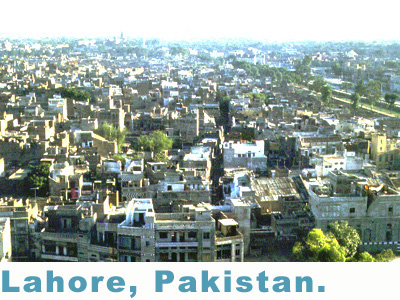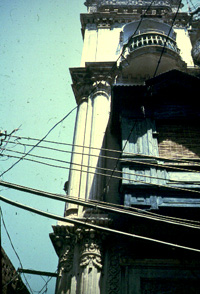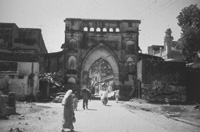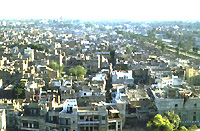|

Conservation of the Urban Fabric
Walled City of Lahore, Pakistan
Zachary M. Kron
INTRODUCTION
This case study on urban development in
the province of Punjab focuses on the Pakistan Environmental
Planning and Architectural Consultant's efforts to create and
implement an urban conservation plan for the walled city of Lahore
in the early 1980's. With a population of four million in 1992,1 this old
quarter of Lahore is under tremendous pressure from commercial
and industrial interests, which as yet have little regard for
the historic nature of the city. In addition to these active
menaces, the city is struggling to integrate new municipal services
into its existent tissue without obscuring its visual character.
Although few interventions have actually been achieved, several
higher profile "pilot projects" have been carried out
in an effort to raise public awareness of the conservation plan.
CONTEXT
Physical
Lahore is the capital of the province
of Punjab, the most fertile area of Pakistan and chief producer
of agricultural products for the country. The city is generally
arid, except for two months of hot, humid monsoons, and receives
less than 20 inches of rain during the course of a year.
Historical
The earliest credible records of
the city date its establishment to around 1050 AD, and show that
its existence is due to placement along the major trade route
through Central Asia and the Indian subcontinent. The city was
regularly marred by invasion, pillage, and destruction (due to
its lack of geographical defenses and general overexposure) until
1525 when it was sacked and then settled by the Mogul emperor
Babur. Sixty years later it became the capital of the Mogul Empire
under Akbar and in 1605 the fort and city walls were expanded
to the present day dimensions. From the mid-18th century until
British colonial times, there was a fairly lawless period in
which most of the Mogul Palaces (havelis) were razed,
marking a "decrease in social discipline towards the built
environment that has continued unabattingly till today."2 Much of the
walled fortification of the city was destroyed following the
British annexation of the region in 1849, as both a defensive
measure to allow the colonists to better control the populous,
and as a commercial enterprise in resale of the brick for new
projects. In 1864 many sections of the wall had been rebuilt.
Major physical contributions of the British to the old city consisted
of piped water and well systems established just outside the
former walls. The building of the railroad and a station well
outside of the old city set the stage for later expansion.3
Social and Economic
A new wave of destruction washed
over the city in 1947 following the partition of British Colonial
India into the Hindu majority nation of India and the Islamic
Republic of Pakistan. The resulting inter-communal strife destroyed
wide areas of the urban fabric, some of which was repaired by
the 1952 Punjab Development of Damaged Areas Act. Many of the
arriving Muslim families from India moved into the emigrating
Hindu residences, although the lower land values of the old city
further established the concentration of lower income groups
in the city center, with wealthier families residing outside.
In the 1950's an organization called the Lahore Improvement Trust
attempted to instate a plan for commercial development in the
old city, but these efforts were largely without effect.4 Between the
early 1970's and '80's, 29% of the old city population moved
out.
The space left by emigrants from the old
city has largely been filled by commercial interests, mostly
small scale manufacturers and wholesalers, many of whom have
national and international clients and do not serve the local
community. The advantages for commercial interests are the readily
available cheap labor force among the urban poor, as well as
relative anonymity, which facilitates the evasion of most national
and local taxation. Advantages for speculative developers lie
in the absence of enforcement of building regulations, as well
as in cheap plots. The resulting commercial encroachment demonstrates
a pattern of abuse of building stock through inappropriate re-use
of structures intended for small scale (cottage) industry and
residential use, as well as destruction of older buildings replaced
with quickly erected, lower quality structures.
To the northwest, in the city of Peshawar,
and to the east, in Delhi, one can find buildings related in
form and age to those in Lahore, although in Peshawar the residential
construction is primarily of wood. Although Peshawar was controlled
by the Moguls and populated with mosques and gardens as Lahore
was during the 16th and 17th centuries, little of it remains
to be seen. Peshawar also has it's share of British construction,
(including the renovated Mahabat Khan Mosque built under Shah
Jehan but largely redone in 1898), and many of the existing residential
buildings date from the late 19th century. Like Lahore, the small
grain of the urban fabric left intact can be attributed to the
growth of the city within a walled fortification.
THE PROJECT
Significance of the Walled City
The walled city of Lahore is the
product of the cultural influences of at least three major empires
in the subcontinent of India: the Mogul Empire, the British colonial
presence, and the modern nation-state of Pakistan. As a result
of its position along a major trade route, it has also been influenced
by many other, less dominant cultures, such as Afghanistan and
China. Unlike Peshawar, which has lost much of it's larger scaled
architectural past, and Islamabad, which can only boast Modern
Monumental architecture of some merit, Lahore contains some of
the best of all the empires which have touched it, as well as
smaller scale vernacular architecture.
In addition to this object value, the walled
city plays a central role in the daily functioning of Lahore.
It remains a bustling center of commerce and represents the "living
culture" of the city, an enduring continuation of and evolution
from a much older way of life. As the city contains many heterogeneous
physical attributes, the activities of the walled city include
all aspects of urban life: residential, manufacturing, retail,
educational, religious, and civic.
CONSERVATION PHILOSOPHY
The Lahore Development Authority's Conservation
Plan for the Walled City of Lahore is a series of recommendations
concerning the physical decay of historic structures in the city,
the "visual clutter" of newer structures and
infrastructure, and the encroachment of various unregulated elements
on the city's fabric. This program of conservation, headed by
Pakistan Environmental Planning and Architectural Consultants
Ltd. (PEPAC) is actually the expansion of a project begun in
1979, the "Lahore Urban Development and Traffic Study"
(LUDTS). This study, undertaken by the Lahore Development Authority
(LDA) and funded by the World Bank, identified four areas for
improvement. "1. Urban planning activities, leading to
the production of a structure plan to provide a framework for
action program within Lahore; 2. Neighborhood upgrading and urban
expansion projects, to provide substantial improvements in living
conditions for lower income groups; 3. Improvement of traffic
conditions in congested parts of the street system of central
Lahore: and 4. Improvements to living conditions within the walled
city by improving environmental sanitation and providing social
support program."5
Part of LUDTS' findings identified the
precarious position of the physical fabric of the city. The report
suggested (among other things) that any development and upgrading
program that the city initiated should include measures "to
protect national and regional cultural heritage," and to
that end it recommended the development of a conservation plan.
The World Bank made the creation of a plan a condition of the
first loans to be issued to Lahore.
The study identifies some 1,400 buildings
within the city as having high architectural or historical value
and presents a series of conservation proposals. These recommendations
include both conservation steps for the buildings themselves,
as well as social and economic programs to halt the causes of
their degradation. In general the study suggested the following:
1. Strategic policies and actions to be taken outside the walled
city.
2. Planning activities and studies for both the central area
and the walled city.
3. Institutional development including the full utilization of
existing resources reinforced with an active training program,
and the application of the legislative resources that already
exist.
4. Urban management and controls to include production of a "Manual
for Conservation and Building Renewal" and improved maintenance
practices.
5. Traffic improvement and management program.
6. Upgrading and enhancing the physical fabric and the urban
environment through upgrading the building stock . . . and through
upgrading urban services.
7. Redevelopment with concern for conformity with the scale,
height, densities and building typologies traditionally characteristic
of the walled city to be demonstrated through projects undertaken
by public authorities on state land and through regulated private
sector activity.
8. Conservation of individual listed special premises or elements.6
CONSERVATION PROGRAM INTERVENTIONS
While the statement above outlines a general
policy approach to the conservation effort, several pilot projects
have been more specifically outlined and a handful have been
implemented and funded by the World Bank through the Punjab Urban
Development Project. The buildings are, in most cases, structures
dating from early British colonial times, both residential and
commercial, and more monumental structures from the Mogul Empire,
although action has only been taken on government owned buildings.
One pilot project that has come directly
out of this effort is the restoration of the Wazir Khan Hammam
(bath house), built in 1638. The bath, which suffered mostly
surface damage to the fresco work, is now being re-used as a
tourist center with some facilities for computer education for
women. While the structure itself was not in any particular risk
of irreversible decay, this hamam is a particularly important
site to the Development Authority because it is located on a
popular entrance point for tourists coming to the city. For visitors
it is the first logical stopping point on a walk that goes from
the impressive Delhi Gate (Image 6) past the Wazir Khan Mosque
and the Choona Mandi Haveli Complex to end at the Lahore Fort.
This route is also well traveled by locals going to the wholesale
cloth and dry goods markets. It seems that the choice of aiming
the rather limited resources of the program at this project is
an attempt to heighten the community interest in the conservation
effort, rather than directly addressing sites with more desperate
conservation needs.
Additionally, there are several proposals
to deal with the conservation of areas surrounding historic monuments.
Of particular concern is the area around the Mori Gate, which
stands next to the well preserved UNESCO site of the Lahore Fort,
and lies between the Fort and the Delhi Gate, immediately adjacent
to the newly conserved and re-used Choona Mandi Haveli Complex.
While the Fort itself is a vigorously monitored and controlled
site, the area immediately surrounding it is "visually cluttered,"
to say the least. One exits the Fort to be confronted by a mass
of electrical cables, transformers, and half a dozen steel recycling
operations.
PEPAC's proposal involves the relocation
of the steel traders (whom it claims are operating illegally)
to a more suitable location and repopulating the area with a
mixture of commercial and residential uses. The area itself does
not contain artifacts of particular merit, but is amid a concentration
of other historic elements.
In their statement of policy and issues,
PEPAC refers to the exemplary conservation work done at the Choona
Mandi Haveli Complex, and to its re-use as a degree college for
women. While this is not a PEPAC project, it is identified as
a model of the work they wish to see happening in the city, and
claim that the project "came out of the conservation effort"
that they are creating.7
While it is unclear from the literature
who in fact has implemented the particular conservation of the
Haveli Complex or what the connection is to the PEPAC
effort, it is clear a particular region of the city has been
identified as a primary site for conservation efforts. It seems
sensible to concentrate on blocks of the city as specific focus
areas for limited resources and as showpieces to use to solicit
further funding, but it is curious that this is not stated as
a strategy in the group's policy statements.
In addition to these concentrated areas
of restoration, the main gates to the city have been chosen as
pilot projects, several of which have already undergone restoration
work. In order to determine how the restored gates should appear,
PEPAC searched for clues not only in their existing condition,
but also in historical documentation of the gates from the pre-colonial
period. In particular, a wealth of information was found in the
numerous renderings by French and British explorers from the
17th century who made paintings, drawings and etchings of the
sites. After identifying the site and determining the changes
that are to occur in the area, the site was "vacated of
encroachers," who currently occupy the niches, hollows and
shelters provided by the wall. Several of the gates have now
been restored to their pre-colonial state, but the work has recently
been halted due to the cessation of World Bank funding.
AUTHOR'S CONCLUSION
The example of the gates highlights several
difficulties faced by PEPAC in the implementation of their conservation
project. First, and perhaps most minor, is the fidelity to the
historical record that the conservators wish to maintain. Although
the accuracy of the sketches can be verified by different views
supplied by different artists, it is not necessarily appropriate
to restore the gates to the condition they were in during that
particular era, especially at the expense of people who may have
some claim to residency in portions of the site.
A more important criticism is that the
definition of "encroacher" is inadequate. The Prime
Minister has attempted to implement a policy to allot property
rights to squatters as a way of instilling greater commitment
in them to properly maintain the areas they occupy.8 However,
PEPAC does not qualify the distinction between squatters, "encroachers,"
and residents. Furthermore, 20 million rupees that have been
earmarked by the Punjab Urban Redevelopment Project for residents
to use for the improvement of their own property was not dispersed
due to the inability of the organization to identify legal residents.9
With no clear definition of who is a resident
it will continue to be impossible to make a generalized policy.
The total absence of legal enforcement of property rights further
undermines any sense of ownership. An example is the rapacious
acts of the speculative developer who buys a building and then
digs a second basement, which effectively collapses the neighboring
buildings. The owner, without legal recourse that would provide
any results, is left with no choice but to sell their ruined
plot to the developer, who then erects a cheap, commercial building.10
This dilemma underscores a central conflict
in the policy of conservation enacted by PEPAC. On the one hand
is the attempt to instate a series of guidelines and regulations
which the residents of the city must follow, and on the other
hand is the attempt to encourage a sense of ownership, pride
and respect among residents for the architecture. The first effectively
removes or reduces the choices of the resident in determining
the form of their surroundings and relies upon a policy of rule
enforcement. The second relies upon the living culture of a place
to perpetuate the existing physical culture, although allowing
for the changing needs of the people. Unless policy is made concerning
ownership and enforcement, these two approaches, which are not
necessarily in conflict, will not act in accord, and will each
remain ineffectual.
It is interesting to note that the areas
where the PEPAC conservation effort has been most effective is
in exclusively government owned properties: schools, municipal
dispensaries, monuments and civic buildings, as well as the homes
of police officials.11
In the case of the other projects that
have been implemented, PEPAC may be criticized for prematurely
starting restoration work before active degradation is stopped,
or even slowed. The resurfacing of the Wazir Khan Hamam and work
on the area between the Delhi and Mori Gate are a prime example
of this, a fairly stable area is being conserved while nearby
buildings are being razed for newer construction or crumbling
through neglect. (Image 9) However, given the dependency
of virtually the entire conservation effort on World Bank funding,
it must be a priority for the group to create a visible, finished
grouping of conserved buildings in order to solicit further funding.
This example of trying to raise consciousness
before actually acting to stop degradation is appropriate for
any conservation project undertaken in Lahore. From the inception
of the current conservation plan, the impetus for preservation
has come from outside the city walls and has been hindered by
a discrepancy between what is said in meeting rooms and what
happens in reality. In the absence of a fairly oppressive and
well-funded preservation enforcement program, conservation in
the walled city will not be effective without the support and
active interest from the people who inhabit it.
Endnotes
1. John King, and John St. Vincent, Lonely
Planet Travel Survival Kit: Pakistan, 4th Edition (Lonely
Planet Publications, 1993), p. 191.
2. PEPAC
3. Pakistan Environmental Planning and
Architectural Consultants Ltd, Lahore Development Authority:
Conservation Plan for the Walled City of Lahore, Final Report,
vol. 1, Plan Proposals (1986), p. 7.
4. Reza H. Ali, "Urban Conservation
in Pakistan: a Case Study of the Walled City of Lahore,"
Architectural and Urban Conservation in the Islamic World,
Papers in Progress, vol. 1 (Geneva: Aga Khan Trust for Culture,
1990), p. 79.
5. Lahore Development Authority /Metropolitan
Planning Wing, with the World Bank/IDA, "Lahore Urban Development
and Traffic Study," Final Report/vol. 4, Walled City Upgrading
Study (August 1980), preface.
6. Ali, "Urban Conservation in Pakistan,"
p. 87.
7. Pakistan Environmental Planning and
Architectural Consultants Ltd, Issues and Policies: Conservation
of the Walled City of Lahore, (Metropolitan Planning Section
Lahore Development Authority, 1996), point 5.
8. Pakistan Environmental Planning and
Architectural Consultants Ltd, Lahore Development Authority,
Conservation Plan for the Walled City of Lahore, Final Report,
vol. 1, Plan Proposals. (1986), p. 180.
9. Pakistan Environmental Planning and
Architectural Consultants Ltd, Lecture given on the Walled City
of Lahore Conservation Project (July 25, 1998).
10. (Sajjad Kausar)
11. PEPAC lecture (25 July 1998).
Bibliography
Ali, Reza H. "Urban Conservation in
Pakistan: a case study of the Walled City of Lahore." Architectural
and Urban Conservation in the Islamic World. Papers in Progress.
vol. 1. Geneva: Aga Khan Trust for Culture, 1990.
Background Paper: Lahore Pakistan. Prepared
for Design for Islamic Societies Studio, MIT Department of Architecture
and Planning, 1992.
King, John and St. Vincent, John. Lonely
Planet Travel Survival Kit: Pakistan, 4th Edition. Lonely
Planet Publications, 1993.
Lahore Development Authority /Metropolitan
Planning Wing, with the World Bank/IDA. "Lahore Urban Development
and Traffic Study," Final Report/vol. 4. Walled City Upgrading
Study. August 1980.
Nadiem, Ihsan H. Lahore: A Glorious
Heritage. Lahore: Sang-e-meel Publications, 1996.
Pakistan Environmental Planning and Architectural
Consultants Ltd. Lecture given on the Walled City of Lahore Conservation
Project. July 25, 1998.
Pakistan Environmental Planning and Architectural
Consultants Ltd. Monographs on the Walled City of Lahore.
Pakistan Environmental Planning and Architectural
Consultants Ltd. Lahore Development Authority. Conservation
Plan for the Walled City of Lahore. Final Report. vol. 1.
Plan Proposals. 1986.
Pakistan Environmental Planning and Architectural
Consultants Ltd. Issues and Policies: Conservation of the
Walled City of Lahore. Metropolitan Planning Section Lahore
Development Authority. 1996.
Qurashi, Samina. Lahore: The City Within.
Singapore: Concept Media, 1988.
Credits All
photographs and illustrations courtesy the Aga Khan Fund, MIT Rotch
Collections, unless otherwise noted below: 1.
Courtesy, KK Mumtaz.
2. Courtesy T. Luke Young.
4. Brian B. Taylor, MIMAR 24, 1987.
5. From Pakistan Environmental Planning and Architectural Consultants, Ltd,
"Conservation Plan for the Walled City of Lahore."
6. Courtesy T. Luke Young.
7a. Brian B. Taylor, MIMAR 24, 1987.
9. Courtesy Hasan Uddin Khan.
|

1. Map
of the fortress of Lahore.

2. Traffic outside the walled city.

3. Encroachment.

4. A bazaar in the Walled city

5. Inside View of the Wazir Khan Hamman, before and after restoration..

6. streets in the old area.


7a and 7b. Electrical infrastructure.

8. Sharanwalla gate.

9. Electrical infrastructure.
Image10. View of the walled city.
|